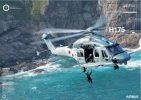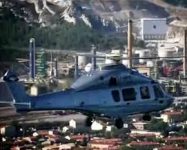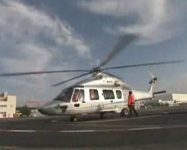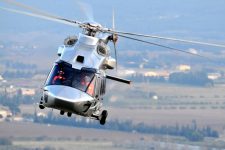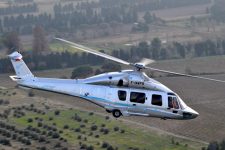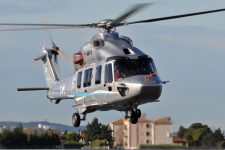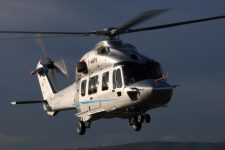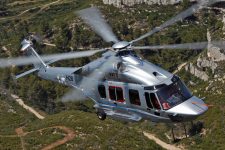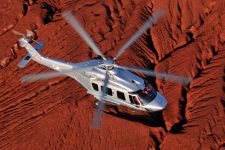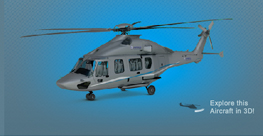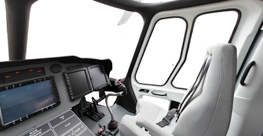New Safety Standards
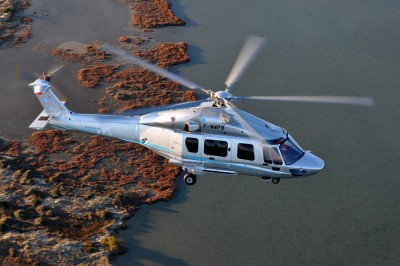 The H175 exceeds EASA CS29 crashworthiness requirements. In addition to general fail-safe design and fully redundant systems, emergency egress capacity exceeds EASA Type IV
The H175 exceeds EASA CS29 crashworthiness requirements. In addition to general fail-safe design and fully redundant systems, emergency egress capacity exceeds EASA Type IV
certification requirements.
Two wide pilot doors, two extra-wide sliding passenger doors and eight large push-out windows allow 16 passengers and 2 pilots to leave the aircraft in a matter of seconds. Oversized front and aft emergency floatation devices are permanently “armed” in flight, and can be inflated at high speeds
The H175 has Sea State 6 capability with a high helicopter waterline. Two oversized 12 to 18-pax life rafts can be easily released by passengers or crew. All emergency evacuation features and scenarios have been designed and validated by Oil & Gas industry safety advisors, operators and pilots.
Bigger cabin, greater comfort
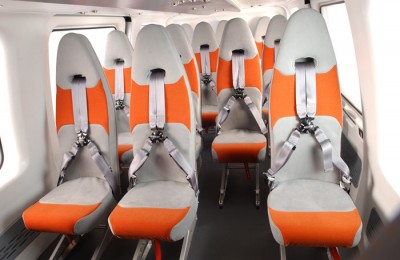 With oil platforms farther and farther out to sea, two hour helicopter rides are now common. Therefore cabin comfort is becoming as important as cost per seat.
With oil platforms farther and farther out to sea, two hour helicopter rides are now common. Therefore cabin comfort is becoming as important as cost per seat.
With the biggest cabin of any medium twin, the H175 offers first-class comfort and ideal seating arrangements with lots of leg room for up to 16 passengers in Oil & Gas configuration. It also has more windows than walls, which ensure panoramic
views for all.
The roomy, flat-floored, unobstructed cabin is easily accessible, thanks to extra-large sliding doors on both sides. The easy cabin access can also accommodate the fork-lift loading of bulky cargo. Two large upward-opening hatches give access to the vast 83 cubic ft / 2.35 m³ luggage compartment. This compartment can also be accessed from the cabin. The H175 was designed with the end user in mind, right down to its low vibration and noise levels. Thanks to the five-bladed main rotor, minimized bearing rotor head and superior soundproofing, it offers the quietest, smoothest-riding 16- seat cabin around— a quality long-haul passengers and pilots will appreciate. Ultimate comfort: cockpit and cabin are individually and automatically air conditioned using automotive quality components.
A cockpit pilots will love
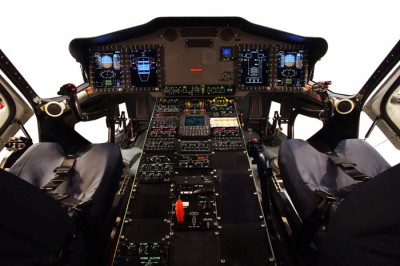 The H175’s spacious cockpit was designed by pilots for pilots. Wide, hinged, hydraulically assisted doors provide effortless access and egress. Immense windows offer an exceptionally large field of vision. The Airbus Helicopters- exclusive, advanced human-machine interface is designed upon helicopter specifics, not just adapted from general aviation. The all-glass, 6X8 inch multi-function LCD displays, plus optional central mission display, offer ideal ergonomics and symbolizations that are truly pilot friendly. The common cockpit concept throughout the Airbus Helicopters range greatly simplifies the addition of the H175 to existing fleets. Advanced caution and warning systems have built-in test functions for fault indication and maintenance of all critical systems cautions and warnings, also associated with audio tones. The H175’s state-of-the-art avionics are derived from the acknowledged H225. The 4-axis dual duplex autopilot provides unrivalled precision and stability for automatic transitions to hover on ships or on shore. It is linked to the Flight Management System for area navigation and all other upper modes: trans up, trans down, hover, etc. All of these pilot-friendly systems, added to the Full Authority Digital Engine Control, substantially reduce pilot workload and enhance pilot precision, even in roughest weather conditions. Open architecture permits easy connection of navigation sensors. In addition, the vast central console comes completely configured, but still has room for many customizations.
The H175’s spacious cockpit was designed by pilots for pilots. Wide, hinged, hydraulically assisted doors provide effortless access and egress. Immense windows offer an exceptionally large field of vision. The Airbus Helicopters- exclusive, advanced human-machine interface is designed upon helicopter specifics, not just adapted from general aviation. The all-glass, 6X8 inch multi-function LCD displays, plus optional central mission display, offer ideal ergonomics and symbolizations that are truly pilot friendly. The common cockpit concept throughout the Airbus Helicopters range greatly simplifies the addition of the H175 to existing fleets. Advanced caution and warning systems have built-in test functions for fault indication and maintenance of all critical systems cautions and warnings, also associated with audio tones. The H175’s state-of-the-art avionics are derived from the acknowledged H225. The 4-axis dual duplex autopilot provides unrivalled precision and stability for automatic transitions to hover on ships or on shore. It is linked to the Flight Management System for area navigation and all other upper modes: trans up, trans down, hover, etc. All of these pilot-friendly systems, added to the Full Authority Digital Engine Control, substantially reduce pilot workload and enhance pilot precision, even in roughest weather conditions. Open architecture permits easy connection of navigation sensors. In addition, the vast central console comes completely configured, but still has room for many customizations.
Operator-designed maintenance concept
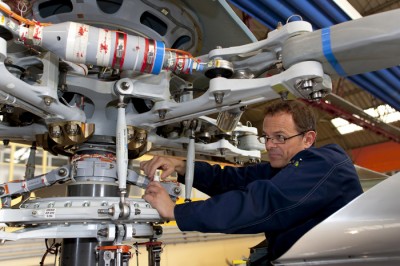 Customer advice and a logistic support analysis based on most advanced standards showed that a new maintenance approach for the H175 would provide significant economic savings. The benefits were achieved, first through a reduction of maintenance workload and costs, by reducing the number of maintenance tasks and their frequency. Secondly, by improving reliability of the different systems. The H175 is a major step in terms of development process and technical integration, with the use of a DMU (Digital Mock Up). This DMU is a virtual helicopter, fully represented in 3D, used as a common basis for all the designers. In addition, this DMU provides outstanding information to generate the documentation and prepare the maintenance operations. The result is Increased availability, reliability and safety, with an inevitable decrease in maintenance costs. Application of ‘’MSG-3’’ methodology to the elaboration of the Master Servicing Manual led to suppression of the usual “after-last-flight” visit, reduced frequency of the Technical Inspection, and complete suppression of the Major Inspection. The Pratt & Whitney PT6C engines are renowned for excellent Time Between Overhaul (5,000 hours). The Spheriflex® design rotor head requires only “On-Condition” maintenance. The rugged but simple airframe has a metallic structure made essentially of extremely light but rigid aluminum alloy. Maritime corrosion treated, it is easy to maintain and easy to repair. Airbus Helicopters offers a comprehensive array of repair and overhaul services to ensure maximum availability with fully controlled costs. Services range from basic OEM repair to comprehensive Parts-By-the-Hour and Oil & Gas Availability Program (OGAP).
Customer advice and a logistic support analysis based on most advanced standards showed that a new maintenance approach for the H175 would provide significant economic savings. The benefits were achieved, first through a reduction of maintenance workload and costs, by reducing the number of maintenance tasks and their frequency. Secondly, by improving reliability of the different systems. The H175 is a major step in terms of development process and technical integration, with the use of a DMU (Digital Mock Up). This DMU is a virtual helicopter, fully represented in 3D, used as a common basis for all the designers. In addition, this DMU provides outstanding information to generate the documentation and prepare the maintenance operations. The result is Increased availability, reliability and safety, with an inevitable decrease in maintenance costs. Application of ‘’MSG-3’’ methodology to the elaboration of the Master Servicing Manual led to suppression of the usual “after-last-flight” visit, reduced frequency of the Technical Inspection, and complete suppression of the Major Inspection. The Pratt & Whitney PT6C engines are renowned for excellent Time Between Overhaul (5,000 hours). The Spheriflex® design rotor head requires only “On-Condition” maintenance. The rugged but simple airframe has a metallic structure made essentially of extremely light but rigid aluminum alloy. Maritime corrosion treated, it is easy to maintain and easy to repair. Airbus Helicopters offers a comprehensive array of repair and overhaul services to ensure maximum availability with fully controlled costs. Services range from basic OEM repair to comprehensive Parts-By-the-Hour and Oil & Gas Availability Program (OGAP).
More Power
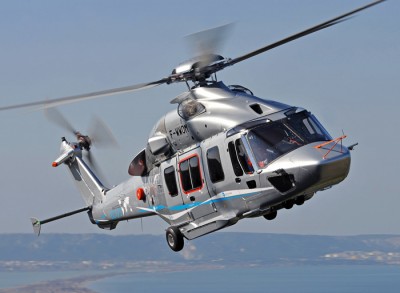 The H175 is powered two proven and reliable Pratt & Whitney PT6C engines. The five-bladed main rotor and three-bladed tail rotor are equipped with blades of a new-generation, profiles and tips. These blades, not only offer a reduction in vibration and noise, but also provide increased lift power and speed. The Spheriflex® design minimized bearing rotor head is damage tolerant. The H175’s brand-new main gearbox has two accessory gearboxes for double redundancy and is capable of a 30 min flight after total loss of oil. De-clutch capability gives Auxiliary Power Unit benefits without the cost and weight of additional equipment. The fuel system, under floor, is a four-tank standard configuration carrying more than 600 US gals (2,300 liters).
The H175 is powered two proven and reliable Pratt & Whitney PT6C engines. The five-bladed main rotor and three-bladed tail rotor are equipped with blades of a new-generation, profiles and tips. These blades, not only offer a reduction in vibration and noise, but also provide increased lift power and speed. The Spheriflex® design minimized bearing rotor head is damage tolerant. The H175’s brand-new main gearbox has two accessory gearboxes for double redundancy and is capable of a 30 min flight after total loss of oil. De-clutch capability gives Auxiliary Power Unit benefits without the cost and weight of additional equipment. The fuel system, under floor, is a four-tank standard configuration carrying more than 600 US gals (2,300 liters).
With its simple architecture, the fuel system offers ground
pressure refueling capability and is designed for safety.
Versatility
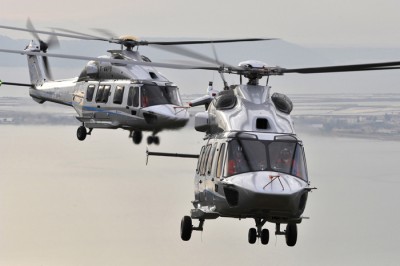 The H175 has been designed to make it operational friendly. Therefore it will offer extreme cabin versatility.
The H175 has been designed to make it operational friendly. Therefore it will offer extreme cabin versatility.
Based on the Oil & Gas configuration, customers will be able to quickly reconfigure the cabin for different missions.
Dedicated SAR and VIP configurations will be introduced next.
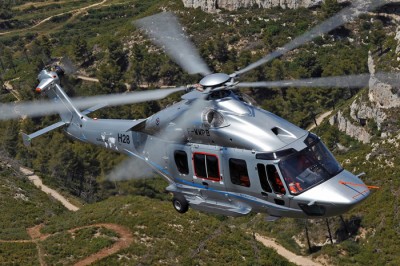 ‘Designed with customers, for customers’
‘Designed with customers, for customers’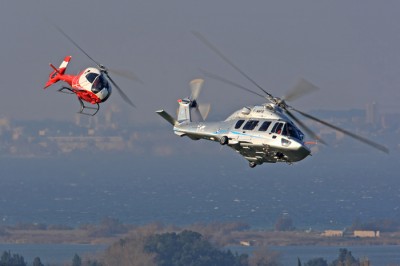 A variety of training devices can be made available at initial delivery that include:
A variety of training devices can be made available at initial delivery that include:



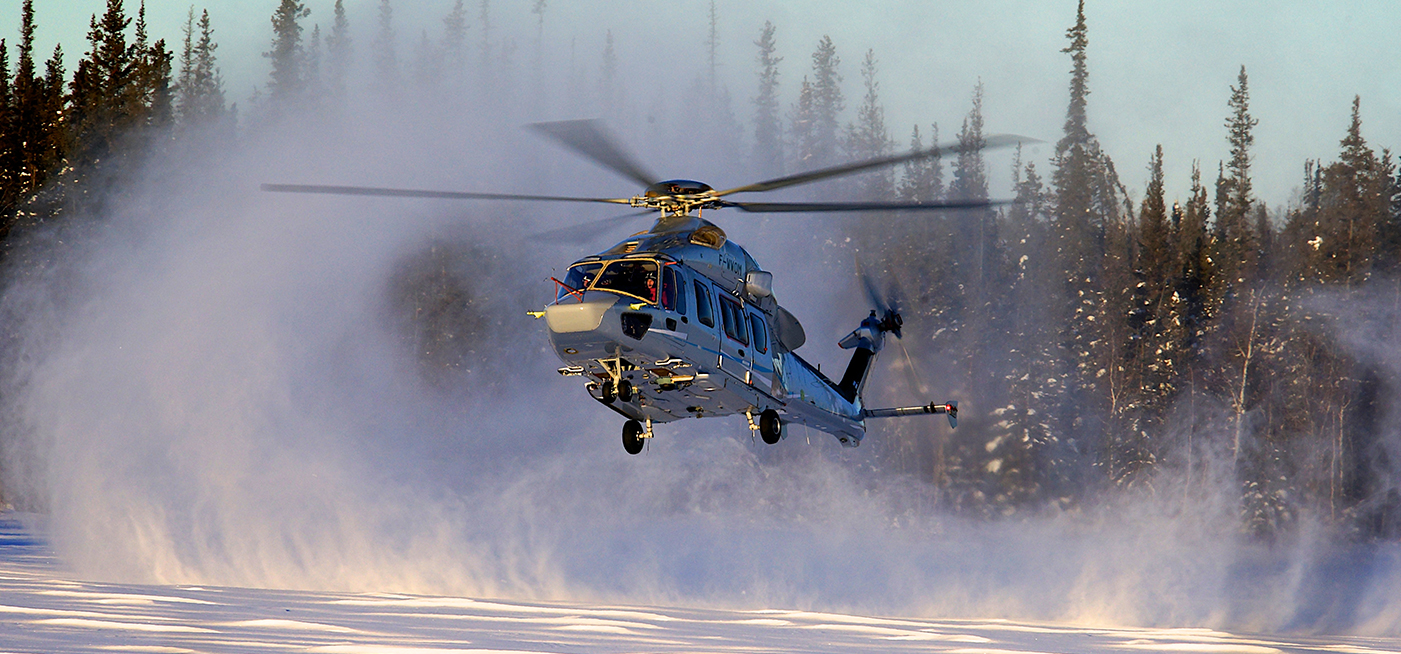
 The H175 exceeds EASA CS29 crashworthiness requirements. In addition to general fail-safe design and fully redundant systems, emergency egress capacity exceeds EASA Type IV
The H175 exceeds EASA CS29 crashworthiness requirements. In addition to general fail-safe design and fully redundant systems, emergency egress capacity exceeds EASA Type IV With oil platforms farther and farther out to sea, two hour helicopter rides are now common. Therefore cabin comfort is becoming as important as cost per seat.
With oil platforms farther and farther out to sea, two hour helicopter rides are now common. Therefore cabin comfort is becoming as important as cost per seat. The H175’s spacious cockpit was designed by pilots for pilots. Wide, hinged, hydraulically assisted doors provide effortless access and egress. Immense windows offer an exceptionally large field of vision. The Airbus Helicopters- exclusive, advanced human-machine interface is designed upon helicopter specifics, not just adapted from general aviation. The all-glass, 6X8 inch multi-function LCD displays, plus optional central mission display, offer ideal ergonomics and symbolizations that are truly pilot friendly. The common cockpit concept throughout the Airbus Helicopters range greatly simplifies the addition of the H175 to existing fleets. Advanced caution and warning systems have built-in test functions for fault indication and maintenance of all critical systems cautions and warnings, also associated with audio tones. The H175’s state-of-the-art avionics are derived from the acknowledged H225. The 4-axis dual duplex autopilot provides unrivalled precision and stability for automatic transitions to hover on ships or on shore. It is linked to the Flight Management System for area navigation and all other upper modes: trans up, trans down, hover, etc. All of these pilot-friendly systems, added to the Full Authority Digital Engine Control, substantially reduce pilot workload and enhance pilot precision, even in roughest weather conditions. Open architecture permits easy connection of navigation sensors. In addition, the vast central console comes completely configured, but still has room for many customizations.
The H175’s spacious cockpit was designed by pilots for pilots. Wide, hinged, hydraulically assisted doors provide effortless access and egress. Immense windows offer an exceptionally large field of vision. The Airbus Helicopters- exclusive, advanced human-machine interface is designed upon helicopter specifics, not just adapted from general aviation. The all-glass, 6X8 inch multi-function LCD displays, plus optional central mission display, offer ideal ergonomics and symbolizations that are truly pilot friendly. The common cockpit concept throughout the Airbus Helicopters range greatly simplifies the addition of the H175 to existing fleets. Advanced caution and warning systems have built-in test functions for fault indication and maintenance of all critical systems cautions and warnings, also associated with audio tones. The H175’s state-of-the-art avionics are derived from the acknowledged H225. The 4-axis dual duplex autopilot provides unrivalled precision and stability for automatic transitions to hover on ships or on shore. It is linked to the Flight Management System for area navigation and all other upper modes: trans up, trans down, hover, etc. All of these pilot-friendly systems, added to the Full Authority Digital Engine Control, substantially reduce pilot workload and enhance pilot precision, even in roughest weather conditions. Open architecture permits easy connection of navigation sensors. In addition, the vast central console comes completely configured, but still has room for many customizations. Customer advice and a logistic support analysis based on most advanced standards showed that a new maintenance approach for the H175 would provide significant economic savings. The benefits were achieved, first through a reduction of maintenance workload and costs, by reducing the number of maintenance tasks and their frequency. Secondly, by improving reliability of the different systems. The H175 is a major step in terms of development process and technical integration, with the use of a DMU (Digital Mock Up). This DMU is a virtual helicopter, fully represented in 3D, used as a common basis for all the designers. In addition, this DMU provides outstanding information to generate the documentation and prepare the maintenance operations. The result is Increased availability, reliability and safety, with an inevitable decrease in maintenance costs. Application of ‘’MSG-3’’ methodology to the elaboration of the Master Servicing Manual led to suppression of the usual “after-last-flight” visit, reduced frequency of the Technical Inspection, and complete suppression of the Major Inspection. The Pratt & Whitney PT6C engines are renowned for excellent Time Between Overhaul (5,000 hours). The Spheriflex® design rotor head requires only “On-Condition” maintenance. The rugged but simple airframe has a metallic structure made essentially of extremely light but rigid aluminum alloy. Maritime corrosion treated, it is easy to maintain and easy to repair. Airbus Helicopters offers a comprehensive array of repair and overhaul services to ensure maximum availability with fully controlled costs. Services range from basic OEM repair to comprehensive Parts-By-the-Hour and Oil & Gas Availability Program (OGAP).
Customer advice and a logistic support analysis based on most advanced standards showed that a new maintenance approach for the H175 would provide significant economic savings. The benefits were achieved, first through a reduction of maintenance workload and costs, by reducing the number of maintenance tasks and their frequency. Secondly, by improving reliability of the different systems. The H175 is a major step in terms of development process and technical integration, with the use of a DMU (Digital Mock Up). This DMU is a virtual helicopter, fully represented in 3D, used as a common basis for all the designers. In addition, this DMU provides outstanding information to generate the documentation and prepare the maintenance operations. The result is Increased availability, reliability and safety, with an inevitable decrease in maintenance costs. Application of ‘’MSG-3’’ methodology to the elaboration of the Master Servicing Manual led to suppression of the usual “after-last-flight” visit, reduced frequency of the Technical Inspection, and complete suppression of the Major Inspection. The Pratt & Whitney PT6C engines are renowned for excellent Time Between Overhaul (5,000 hours). The Spheriflex® design rotor head requires only “On-Condition” maintenance. The rugged but simple airframe has a metallic structure made essentially of extremely light but rigid aluminum alloy. Maritime corrosion treated, it is easy to maintain and easy to repair. Airbus Helicopters offers a comprehensive array of repair and overhaul services to ensure maximum availability with fully controlled costs. Services range from basic OEM repair to comprehensive Parts-By-the-Hour and Oil & Gas Availability Program (OGAP). The H175 is powered two proven and reliable Pratt & Whitney PT6C engines. The five-bladed main rotor and three-bladed tail rotor are equipped with blades of a new-generation, profiles and tips. These blades, not only offer a reduction in vibration and noise, but also provide increased lift power and speed. The Spheriflex® design minimized bearing rotor head is damage tolerant. The H175’s brand-new main gearbox has two accessory gearboxes for double redundancy and is capable of a 30 min flight after total loss of oil. De-clutch capability gives Auxiliary Power Unit benefits without the cost and weight of additional equipment. The fuel system, under floor, is a four-tank standard configuration carrying more than 600 US gals (2,300 liters).
The H175 is powered two proven and reliable Pratt & Whitney PT6C engines. The five-bladed main rotor and three-bladed tail rotor are equipped with blades of a new-generation, profiles and tips. These blades, not only offer a reduction in vibration and noise, but also provide increased lift power and speed. The Spheriflex® design minimized bearing rotor head is damage tolerant. The H175’s brand-new main gearbox has two accessory gearboxes for double redundancy and is capable of a 30 min flight after total loss of oil. De-clutch capability gives Auxiliary Power Unit benefits without the cost and weight of additional equipment. The fuel system, under floor, is a four-tank standard configuration carrying more than 600 US gals (2,300 liters). The H175 has been designed to make it operational friendly. Therefore it will offer extreme cabin versatility.
The H175 has been designed to make it operational friendly. Therefore it will offer extreme cabin versatility.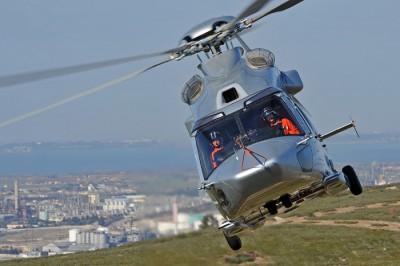 The H175 is powered by proven and reliable Pratt & Whitney PT6C engines.
The H175 is powered by proven and reliable Pratt & Whitney PT6C engines.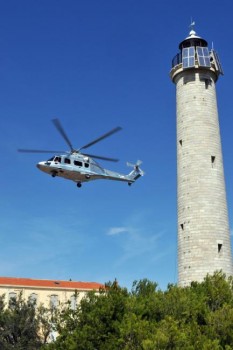 The H175’s wide cabin carries up to 16 passengers. In fact, it is the only 16 pax craft in its class. It provides unrivaled comfort and the highest levels of accessibility and visibility. The H175 has the highest useful volume and payload, as well as, the highest performance and range in its class. This means it can carry more passengers on more round trips per day, at a lower cost per seat, than any other
The H175’s wide cabin carries up to 16 passengers. In fact, it is the only 16 pax craft in its class. It provides unrivaled comfort and the highest levels of accessibility and visibility. The H175 has the highest useful volume and payload, as well as, the highest performance and range in its class. This means it can carry more passengers on more round trips per day, at a lower cost per seat, than any other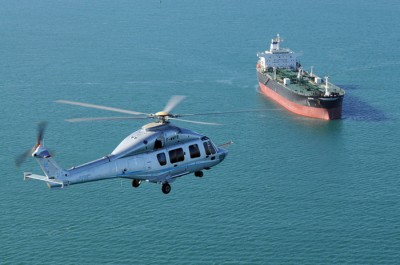 Thirty years of global operations have made Airbus Helicopters the number one partner for offshore petroleum and gas companies. Our new line of aircraft, the widest and latest on the market is built on our extensive experience (6.1 million total flight hours) and our in-depth knowledge of your business needs. Our aircraft are designed to satisfy all your operational requirements, providing the latest avionics technology, high levels of safety and service and unmatched profitability.
Thirty years of global operations have made Airbus Helicopters the number one partner for offshore petroleum and gas companies. Our new line of aircraft, the widest and latest on the market is built on our extensive experience (6.1 million total flight hours) and our in-depth knowledge of your business needs. Our aircraft are designed to satisfy all your operational requirements, providing the latest avionics technology, high levels of safety and service and unmatched profitability.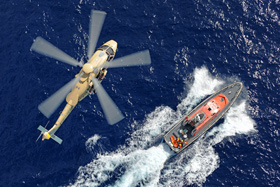 In search and rescue (SAR) operations, the H175 is a high performer offering the greatest endurance (6 hours), longest range, and highest cruise speed in its class, with a standard fuel tank capacity of more than 2 tons.
In search and rescue (SAR) operations, the H175 is a high performer offering the greatest endurance (6 hours), longest range, and highest cruise speed in its class, with a standard fuel tank capacity of more than 2 tons.